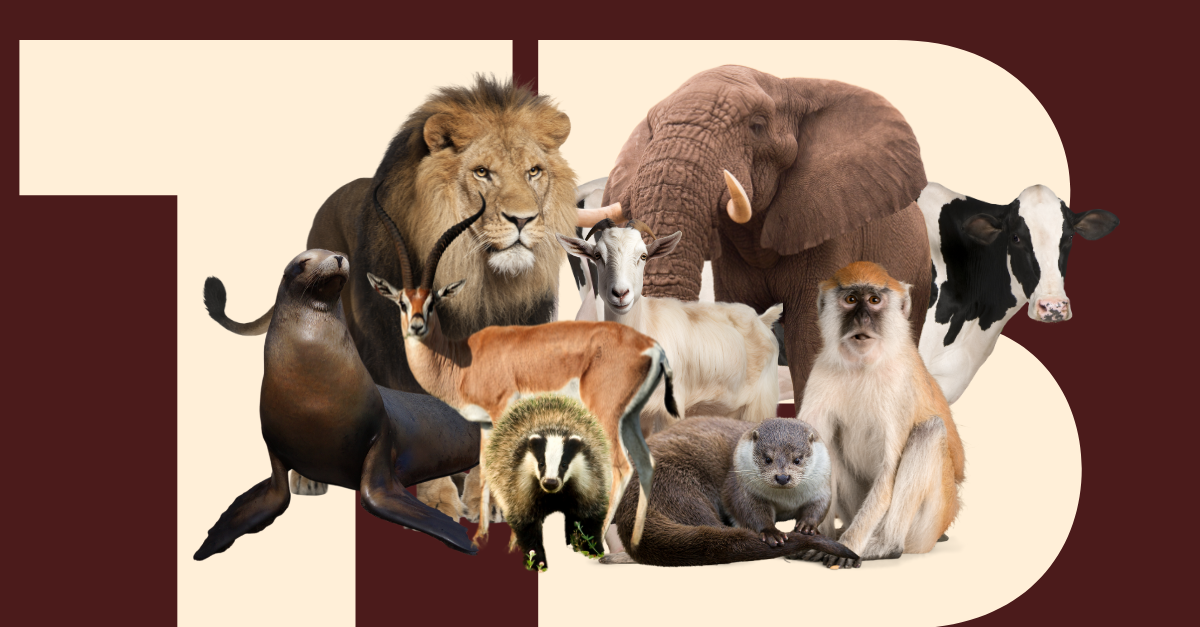Sarah Fortune answers questions on TB in animals

We study tuberculosis (TB) in people, but TB is a problem for wild and captive animals too, often infected by humans. Preventing, diagnosing, and treating TB across species is a shared priority for global health, conservation, and humane care.
We asked a few FAQs to Prof. Sarah Fortune, leading expert on TB and Chair of the Department of Immunology and Infectious Diseases at the Harvard T. H. Chan School of Public Health. Here are her answers with links to sites that we find interesting (but are not people whose work we have evaluated professionally):
Is TB found in animals?
Yes. Tuberculosis is not only a human disease—it affects a wide range of animal species across the globe. Animals can be infected with the same strain of TB (Mycobacterium tuberculosis) that causes disease in people and probably were originally infected by people. There is a closely related TB strain (Mycobacterium bovis) that is even more virulent in many animals –and can infect people – and some TB strains that are specialized for just one kind of animal like goats or seals or voles.
Does TB cause disease in the infected animals?
Yes. TB is a very serious threat to animals. Animals and humans have many of the same symptoms like lung disease, wasting and death. The human strain of TB is a problem in elephants held in zoos or game parks where it can then pose threats to visitors and zoo staff. Bovine TB is an especially serious problem in some wild animal populations –for example Kruger National Park, where it is spreading between buffalo, their predators like lions and then on to other endangered species like rhinoceros.

In the central United States, bovine TB is a significant threat to agricultural cattle herds which can be infected by white tailed deer. Sometimes there is spillover transmission of bovine TB to people. Efforts to stop TB transmission in cattle have been in place since 1917 as part of the National Tuberculosis Eradication Program, which includes depopulation of herds in which TB is detected and pasteurization of milk, and more recently deer herd reduction.
How do you know if an animal has TB?
Diagnosing TB is complicated in animals and people. Some of the tools we use to diagnose TB infection in both animals and people are detecting a specific kind immune response to the bacterium. (Our consortium, Hi-IMPAcTB, discovered that these approaches miss a set of people whose immune responses are different than we expected. We don’t know how this might translate to animals.). TB disease can also be diagnosed by culturing the bacterium from animals. TB culture can take weeks, however, and getting the right specimen to culture can be prohibitively difficult in wild animals and even in captive animals poses challenges.
Can we treat animals with TB?
Treating TB in humans is hard. It requires 4- 6 months of multiple antibiotics every day. Treating animals is even harder. Some of the most effective human antibiotics do not even work against animal TB strains and animals can require even longer courses of treatment. This may be feasible in zoo animals, but it’s impossible for animals in the wild or in large game reserves. That’s why there is an urgent need for better, more protective vaccines.
Isn’t there a TB vaccine already?
Yes—the BCG vaccine (Bacillus Calmette–Guérin) is the same vaccine used in children but was originally developed for cattle over 100 years ago. In human babies, it prevents TB meningitis but does not protect against lung infection or spread. In animals, BCG is also imperfect, providing only modest protection against infection and transmission. Moreover, in some species of animals, it does not work at all
NIH-funded research is focused on developing:
- Better diagnostics
- New vaccines
- Shorter and more effective treatments
- Many of the same bacteria—and the same scientific challenges—are shared across species. This is exactly why cross-species TB research is so important.
To learn more about TB in Animals:
Evaluation of Mycobacterium tuberculosis (TB) Transmission from Asian Elephants to Zoo
Employees
TB – Mycobacterium Bovis Tuberculosis


